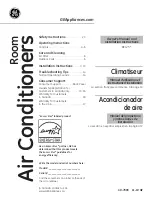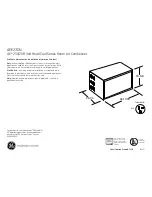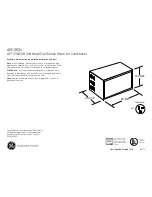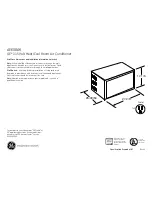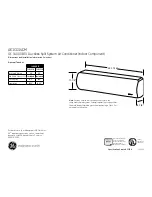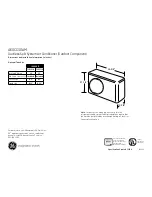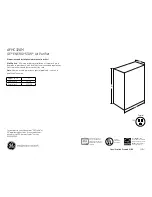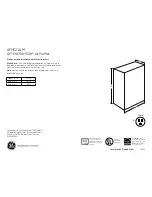
ERV & HRV: User and Installer Manual
Manufacturer reserves the right to change, at any time, specifications and designs without notice and without obligations.
15
INSTALLER’S TROUBLESHOOTING (CONT’D)
ERROR
DESCRIPTION
SOLUTION
E26
Supply motor (drive over temp)
STEP 1: Validate if the air exchanger is exposed to ambient temperatures within the
operating limits
(LOCATING AND MOUNTING THE UNIT on p4)
If STEP 1 did not fix the problem, perform STEP 2: Replace the electronic assembly.
E32
Exhaust airflow
STEP 1: Perform a visual inspection of the exhaust damper system. Clean filters,
distribution registers and outside supply hood. Inspect ducting to ensure it is not squeezed
or bent.
If STEP 1 did not fix the problem, perform STEP 2: Remove ducting of the supply path. On
the LCD screen, select MAX to check if the unit is able to reach the selected flow. If so,
review the ducting path.
If STEP 2 did not fix the problem, perform STEP 3: On the LCD screen, select the MIN and
MAX flow setting values then reset the unit. MAX flow value will display on the LCD
screen. If MAX flow is above desired MAX flow, set MAX and MIN flows.
If STEP 3 did not fix the problem, perform STEP 4: Replace the exhaust blower and repeat
STEP 3.
If STEP 4 did not fix the problem, perform STEP 5: Replace the electronic assembly.
E33
Exhaust motor (drive over current)
STEP 1: Unplug/plug unit.
If STEP 1 did not fix the problem, perform STEP 2: Remove core and clear the ventilation
wheel from any dirt or obstacles.
If STEP 2 did not fix the problem, perform STEP 3: Disconnect J3 (red) and connect a spare
blower system. If it works, replace exhaust blower. If STEP 3 did not fix the problem,
perform STEP 4: Replace the electronic assembly.
E37
Exhaust motor (drive foc duration)
E38
Exhaust motor (drive speed feedback)
E39
Exhaust motor (startup)
E34
Exhaust motor (drive over voltage)
STEP 1: Unplug/plug unit. Under and over voltage may be detected with severe in-house
power supply fluctuation and stop the motor for protection. If STEP 1 did not fix the
problem, perform STEP 2: Replace the electronic assembly.
E35
Exhaust motor (drive under voltage)
E36
Exhaust motor (drive over temp)
STEP 1: Validate if the air exchanger is exposed to ambient temperatures within the
operating limits
(LOCATING AND MOUNTING THE UNIT on p4)
If STEP 1 did not fix the problem, perform STEP 2: Replace the electronic assembly.
E40
Outside air thermistor
STEP 1: Check if thermistor is well connected in connector J7A.
If STEP 1 did not fix the problem, perform STEP 2: Disconnect connector J7A and check if
the measured resistance (thermistor connector) is within 5 Kohms to 120 Kohms. If outside
the range, replace the thermistor.
If STEP 2 did not fix the problem, perform STEP 3: Replace the electronic assembly.
E41
Distribution air thermistor
STEP 1: Check if thermistor is well connected in connector J7B.
If STEP 1 did not fix the problem, perform STEP 2: Disconnect connector J7B and check if
the measured resistance (thermistor connector) is within 5 Kohms to 120 Kohms. If outside
the range, replace the thermistor.
If STEP 2 did not fix the problem, perform STEP 3: Replace the electronic assembly.
E42
PCBA thermistor fault
STEP 1: Replace the electronic assembly.
E43
PCBA temperature over limit
STEP 1: Validate if the air exchanger is exposed to ambient temperatures within the
operating limits
(LOCATING AND MOUNTING THE UNIT on p4)
If STEP 1 did not fix the problem, perform STEP 2: Replace the electronic assembly.
E50
Wall control communication lost
STEP 1: Unplug unit, inspect wires, plug unit.
If STEP 1 did not fix the problem, perform STEP 2: Remove wall control from the wall
installation and test with a short cable. If it works, bring a new cable to the wall installation
location.
If STEP 2 did not fix the problem, perform STEP 3: Test the air exchanger with a spare wall
control. If it works, replace the wall control.
If STEP 3 did not fix the problem, perform STEP 4: Replace the electronic assembly.
E51
Wall control sensor
STEP 1: Unplug unit, inspect wires, plug unit.
If STEP 1 did not fix the problem, perform STEP 2: Replace the wall control.
E60
Protection mode
STEP 1: Perform general inspection of the unit (dampers, core, filters).






















